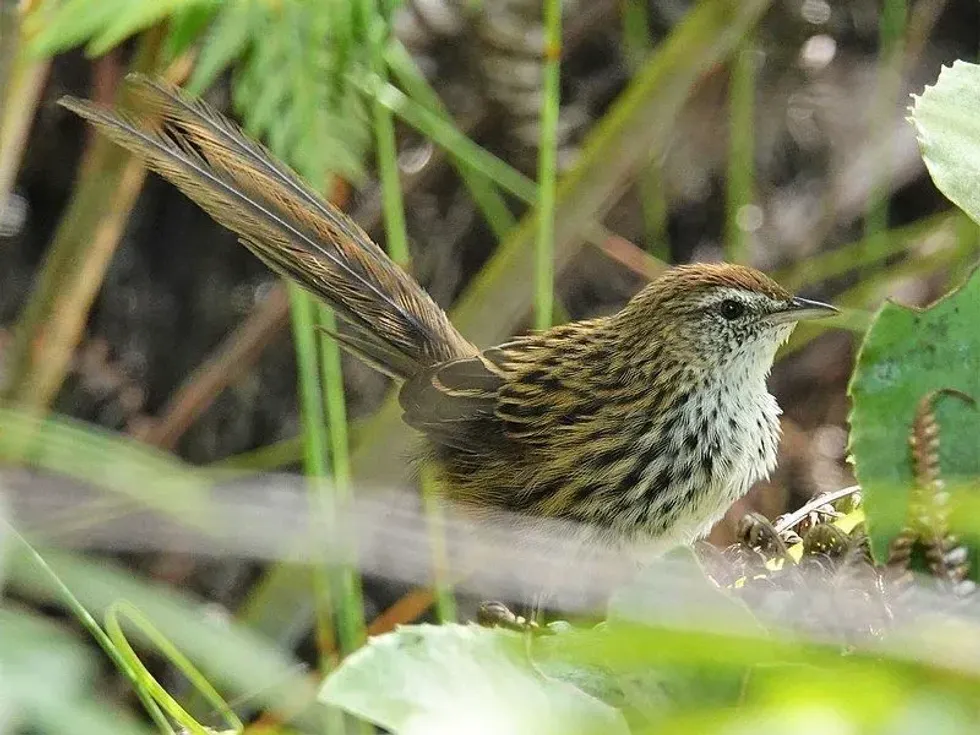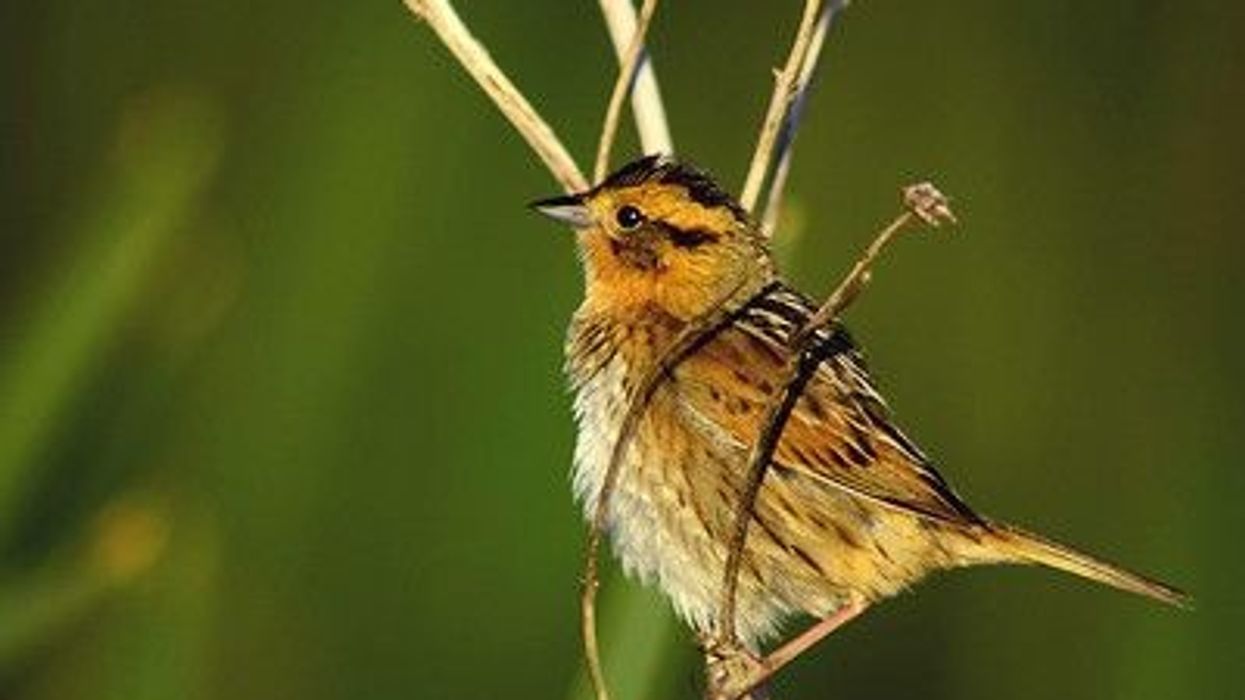Locustellidae is a family of small to medium-sized insectivorous songbirds commonly known as warblers, formerly known as the Old World warbler wastebin family. This family was introduced and described by Charles Lucien Jules Laurent Bonaparte, 2nd Prince of Canino and Musignano, a French ornithologist and biologist in 1854.
Occasionally, it is also called Megaluridae, but Locustellidae is prefeed more.
Grass warblers, grassbirds, and the Bradypterus (bush warblers) are some members that belong to this family.
These birds can be found throughout Africa, Europe, Asia, and some parts of Australia. This article will tell you everything you need to know about a special bird species belonging to Locustellidae, including details about its physical appearance, habitats, population size, distribution or range, conservation status, diet, song, feeding, breeding, and nesting habits!
The New Zealand fernbird or simply fernbird is an insectivorous bird endemic to New Zealand and is a genus of Poodytes.
It was introduced and described in 1832 by two French zoologists and naturalists, Jean René Constant Quoy and Joseph Paul Gaimard, they found a specimen while exploring the Tasman Bay in South Island, New Zealand. These birds were later assigned several binomial names such as Bowdleria punctata, Synallaxis punctata, and Megalurus punctatus.
Their local name given by the Maori tribe is mātātā (Matata).
Fernbirds (Bowdleria punctata) are known for their incredible camouflage, they hid and live in thick, and dense vegetation within their range, they move mainly on foot or in brief flights. The best way to identify them is by their unremarkable morphological features- short wings and a long tail.
So far, five subspecies have been recognized: South Island fernbird (Bowdleria punctata punctata), North Island fernbird (Bowdleria punctata vealeae), Stewart Island fernbird (Bowdleria punctata stewartiana), codfish Island fernbird (Bowdleria punctata wilsoni), snares fernbird (Bowdleria punctata caudata).
If you enjoyed the description of fernbirds, then check out some other birds from our blackpoll warbler facts and whiskered treeswift facts pages.
Fernbird Interesting Facts
What type of animal is a fernbird?
A fernbird (Mātātā) like its name suggests is a bird belonging to the Animalia kingdom.
What class of animal does a fernbird belong to?
Fernbirds (Mātātā) belong to the Aves class.
How many fernbirds are there in the world?
The accurate population size of this bird species is unknown, but they are considered common birds by locals.
Where does a fernbird live?
Fernbirds (Mātātā) are native to New Zealand, the distribution of these birds occurs throughout New Zealand.
The subspecies are named according to the regions they occupy and are common.
The North island fernbird (Bowdleria punctata vealeae) is found in Central North island or Hawke's Bay (uncommon in the southern North Island and Canterbury), the Stewart island fernbird (Bowdleria punctata stewartiana) is found along the shorelines of the Stewart island, the codfish island fernbird (Bowdleria punctata wilsoni) is found near the codfish island, snares fernbird (Bowdleria punctata caudata) is found on the snares island, and the South island fernbird is found in the southern islands.
What is a fernbird's habitat?
Fernbirds (Mātātā) are ground-dwelling birds and their habitat includes tussock-covered areas, reedbeds saltmarshes, several types of wetlands, like drier wetlands, and wetlands with dense vegetation, and regions with temperate climatic conditions.
Who do fernbirds live with?
Fernbirds (Mātātā) are solitary and prefer living and foraging alone, but are often spotted in pairs carrying out several activities in pairs.
How long does a fernbird live?
Fernbirds (Mātātā) have an average lifespan of two to three years. The oldest recorded fernbird was six years old!
How do they reproduce?
Fernbirds are monogamous, meaning the birds mate with a single bird every season.
A male performs various acts to attract a suitable female, once paired up they usually remain together all year round and form long-term bonds.
A short while before the breeding season to keep predators like snakes at bay, both parent birds search for a safe spot to build their nest, these birds are highly territorial and often engage in combat to claim a spot.
The nest is well-hidden, cup-shaped, and larger than most medium-sized bird nests, it is made of woven grass, twigs, shredded barks, moss, and lined with finer materials.
The breeding season begins in August and lasts until early January for most birds, and for some, it is from October to February.
The female birds lay two to four pale pink eggs that are covered with dark brown spots. Both parents participate in the process of incubation and take turns, the eggs hatch about two weeks after they are laid.
After hatching the young chicks stay in their nest for a week or two, until they grow into juveniles, leaving the nest to search for their breeding territories.
What is their conservation status?
The IUNC Red List of Threatened Species has classified fernbirds (Mātātā) as species of Least Concern, and do not face the dangers of going extinct. However, drainage and widespread destruction of wetlands (their natural habitat), and heavy predation by rats and feral cats have adversely affected their population size in the past decade.
Fernbird Fun Facts
What do fernbirds look like?
More often heard than seen because of their amazing camouflage and hiding skills, New Zealand fernbirds are small to medium-sized birds, length-wise they are slightly larger fox sparrows.
Adults have rich brown spots, and boldly streaked plumage, black streaks, and a chestnut brown crown over the head, upper parts, and wings have finer white streaks, pale brown, and elongated tail, that often appears derelict.
The underparts, chin, throat, breast, and belly are white-brown, with tiny brown spots and streaking patterns that can be seen on the belly and breast, the flanks are rich brown with blackish streaking, ears are pale grey and merge into the upperparts, the bill is black with an ash-grey undertone, the eyes are dark brown, the legs and feet are pink-beige.
Both sexes are identical.
A young juvenile resembles the adults but has a duller plumage with lesser streaks.

How cute are they?
Fernbird feathers are really pretty, they have detailed plumage, and mostly walk to reach their destination which makes them look really cute!
How do they communicate?
Although these birds are difficult to observe due to the dense habitat they occupy, they can be located by their song or call, as they can be heard from quite a distance. The notes mixed with their calls and songs sound like- a soft 'uuu', a sharp, high-pitched 'teeeeck', 'tootlit', and a series of repeated 'di-di-di'.
How big is a fernbird?
Fernbirds grow up to 7 in (18 cm) in size.
A crested duck is nearly four times bigger than fernbirds.
How fast can a fernbird fly?
Even though a fernbird wingspan extends up to 8.6 in (22cm) in length, it is a poor flier as it has short wings but a long tail, which makes flying long distances difficult. Thus, it prefers walking on foot more than flying.
How much does a fernbird weigh?
Adult New Zealand fernbirds weighs about 1.2 oz (35 g).
What are the male and female names of the species?
These birds do not have separate names for their male and female bird species. They are simply denoted as males and females.
What would you call a baby fernbird?
Baby fernbirds are called chicks.
What do they eat?
The New Zealand fernbird's diet mainly includes invertebrates such as caterpillars, grubs, beetles, dragonflies, moths, spiders, and other insects. Near wetlands, with thick vegetation, it may even feed on seeds, fruits, and some plants. Fernbirds from southern islands forage among leaf litter and move tiny rocks or pebbles with their bill to look for worms.
Wild animals such as weasels, snakes, and predatory birds like falcons often prey on this species.
Are they poisonous?
No, they are not poisonous.
Would they make a good pet?
No, these birds are wild and may have a hard time adjusting to places outside their natural habitat (wetlands and islands). They are best left to live with their kind.
Did you know...
New Zealand Fernbirds are closely related to the grassbirds- Megalurus of Australia and Africa.
Chatham island fernbird (P. rufescens) was a subspecies of this species and was endemic to the Chatham Islands, but they became extinct around 1900.
How did fernbirds get their name?
The common English name- Fernbird, of this bird contrary to popular belief, is not a reference to their habitat, but to the tail’s worn-out appearance that resembles fern fronds.
The Maori name for the fernbird, mātātā (Matata) was given to the species by the Maori tribe, they respect and admire the fernbird as an oracle or ‘wise bird’ some interpret their calls as signs of success or failure.
Are fernbirds endangered?
Even though considered as common birds, their population size has been decreasing due to drainage of wetlands, and mammalian predation. Several birds from the mutton-bird islands (Solomon, Pukeweka, and Big South Cape islands) and Snares island were eliminated by rats, and feral cats.
The same incident took place at Kundy and Jacky Lee islands. Many Fernbirds living near the Aldermen islands died due to starvation.
A few birds have been re-established by translocation. North Island Fernbirds were relocated to areas of Tiritiri Matangi Island and Stewart island Fernbirds to Kundy island.
Here at Kidadl, we have carefully created lots of interesting family-friendly animal facts for everyone to discover! For more relatable content, check out these hummingbird facts and eastern kingbird facts pages.
You can even occupy yourself at home by coloring in one of our free printable fernbird coloring pages.










